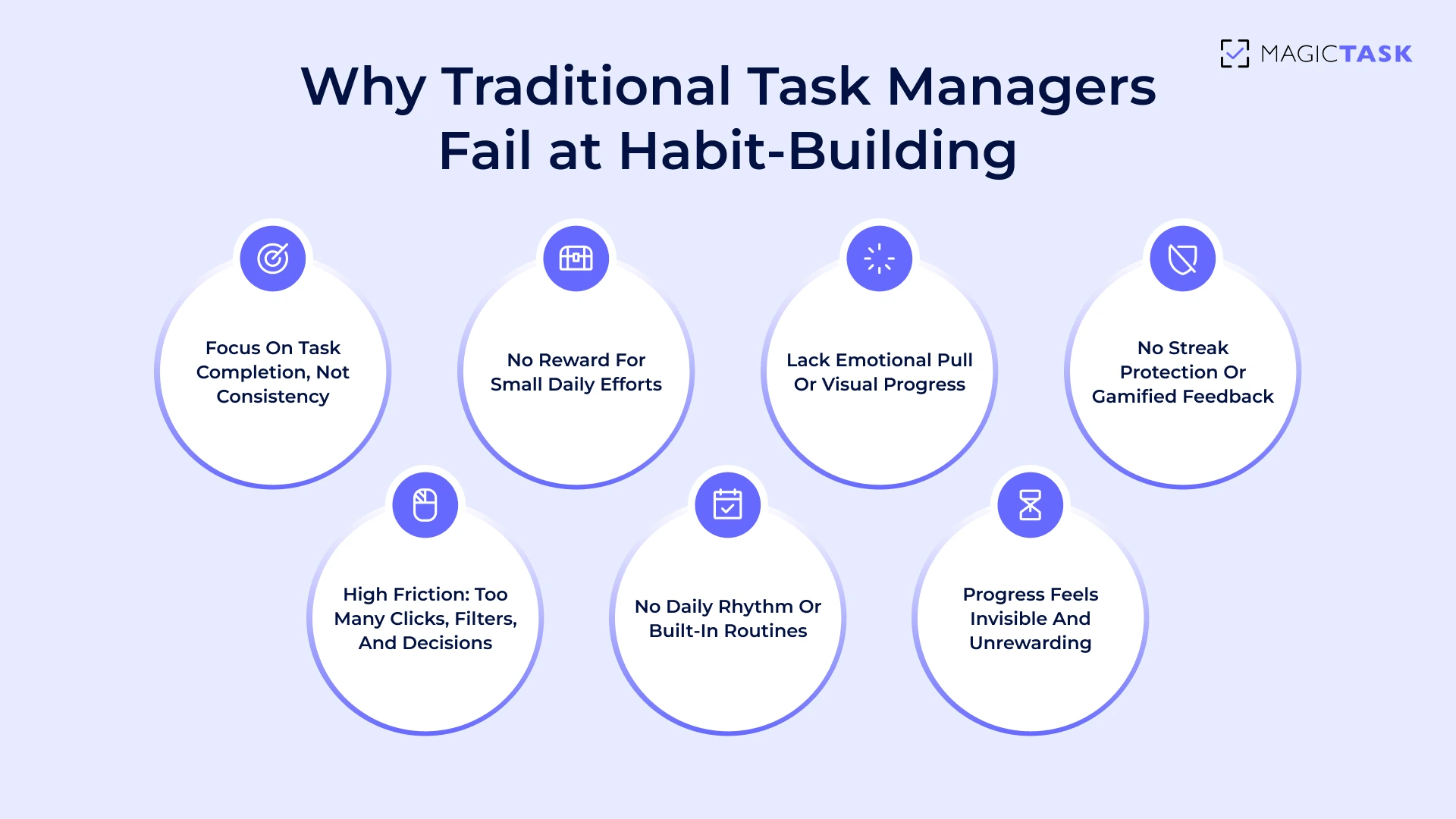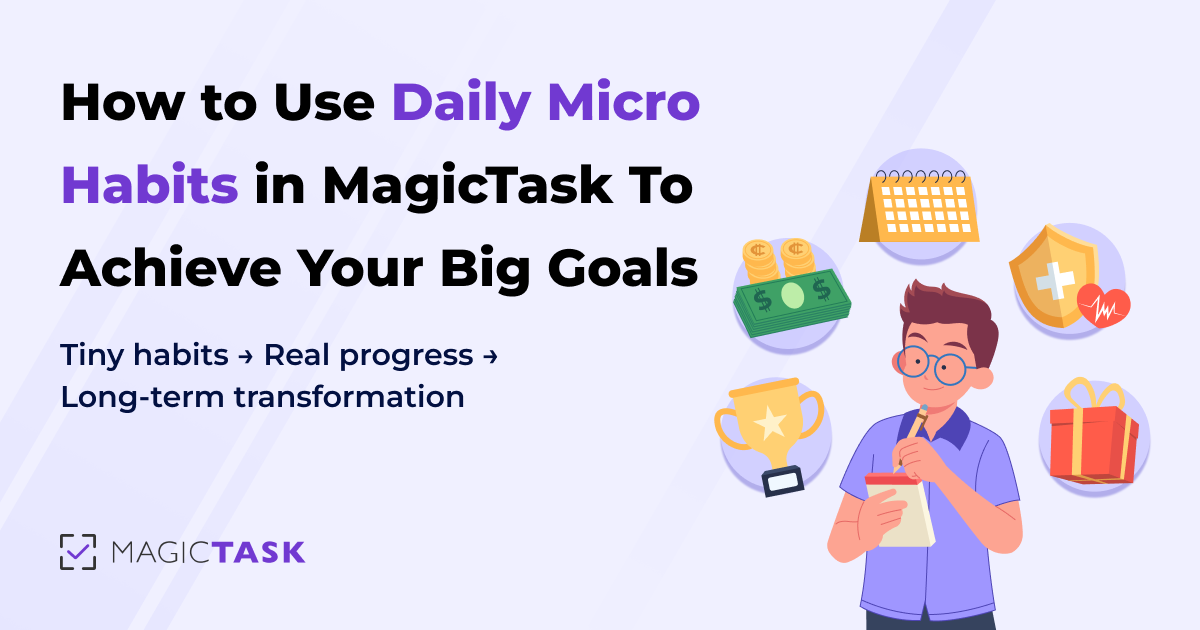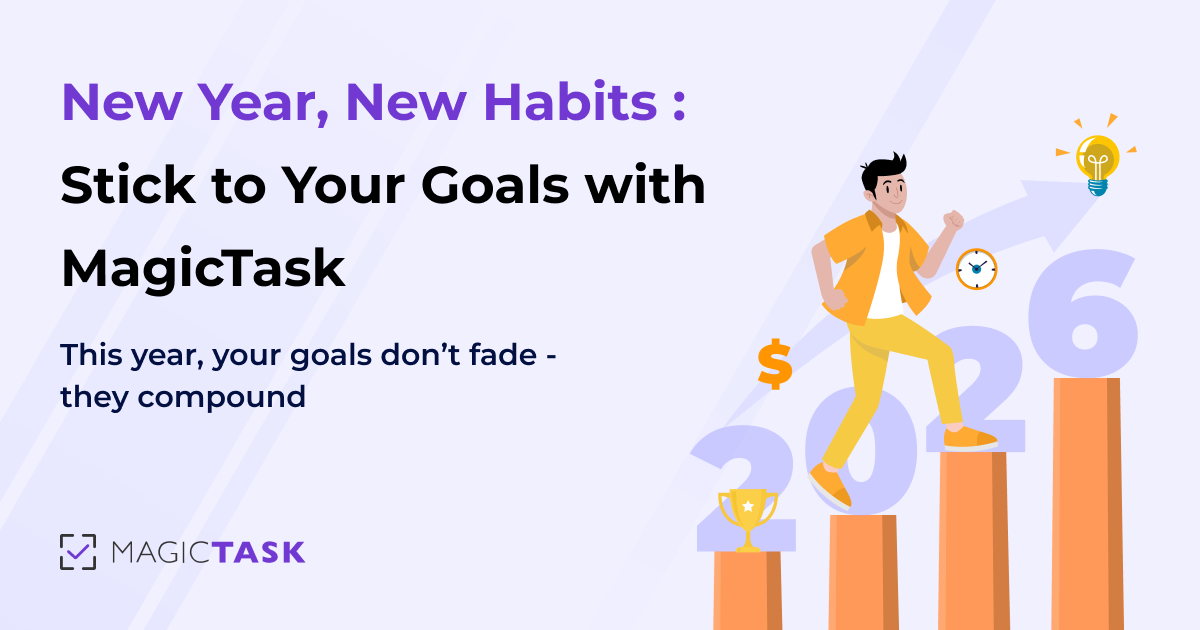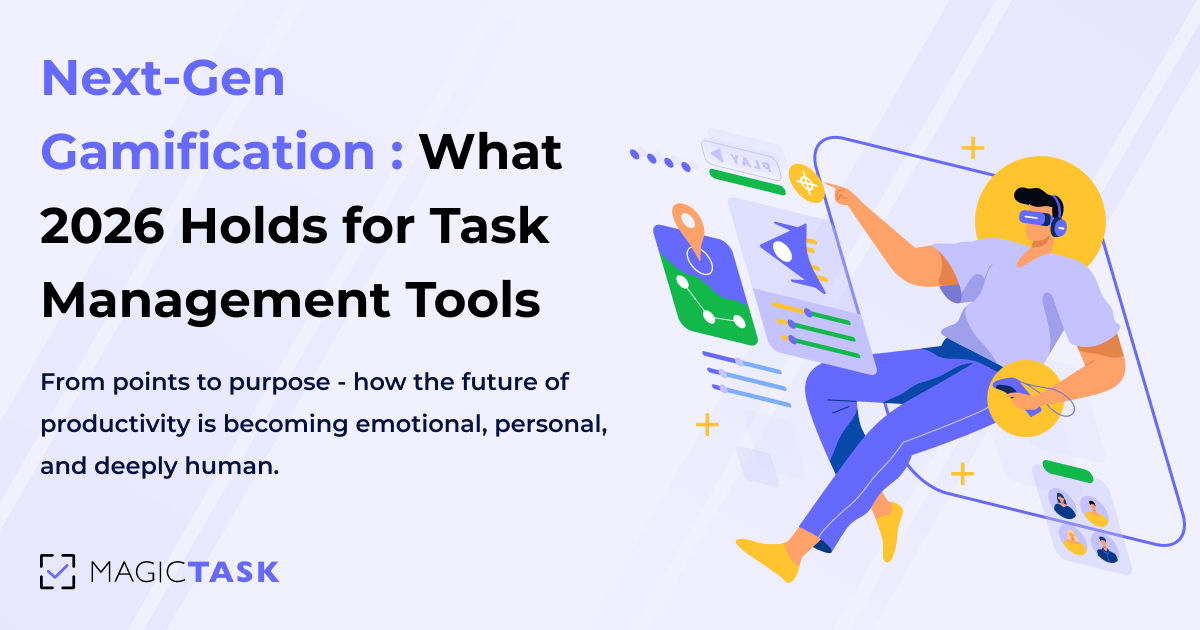Stop Forcing Productivity & Turn It Into a Daily Habit Instead

If you're still relying on bursts of motivation to get things done, you're on the fast track to burnout.
Forcing productivity can work for a while. However, if things continue to slip, the issue is probably not a lack of motivation. It’s how your day is set up.
What you need is rhythm. Something steady. Quiet. Repeatable.
Habits beat motivation every time. When the right ones are in place, you're not waking up and negotiating with yourself. You just move.
But habits don’t build themselves. You need a system that makes them easier to stick with.
In this post, we’ll explore how consistency works, what helps habits form, and how the right tools can make productivity feel automatic instead of forced.
Why You’re Struggling to Stay Productive (Even With Good Intentions)
Productivity doesn’t crumble because you lack ambition; it crumbles because motivation is a limited resource. It spikes unpredictably and disappears under pressure, making it a poor foundation for daily work.
Instead of installing repeatable systems, most people default to motivation-chasing. This leads to a predictable loop: a rush of focus, followed by inconsistency, then drop-off.
Not because the task was too big, but because there was nothing in place to keep you going when the buzz wore off.
That constant context-switching contributes to:
- Mental fatigue
- Task avoidance
- Poor prioritization
- Decision paralysis after minor setbacks
Without a simple way to reduce friction and reinforce progress, even the best intentions fade.
The fix is building smarter. A system that carries the momentum for you, especially when your mood, motivation, or mental bandwidth won’t.
What It Takes to Make Productivity a Habit
Most productivity advice focuses on effort, emphasizing the importance of waking up earlier, pushing harder, and staying disciplined. But what drives long-term output isn’t intensity. It’s consistency.
The key is designing behavior that repeats without negotiation. That’s where the habit loop comes in, a concept made famous by Charles Duhigg:
Cue → Routine → Reward
It’s how brushing your teeth every morning became automatic. Not because you love it, but because the loop is frictionless. The same loop applies to your workday. The smoother the entry, the more likely you are to repeat it.
Let’s say your goal is to write more. Instead of saying, “I’ll write every day,” try:
- Cue: Make coffee
- Routine: Write one paragraph
- Reward: Check off the task in your task management platform
This small loop does more than help you check off tasks. It shapes who you believe you are.
Over time, the repetition of showing up (even briefly) rewires how you see yourself. You’re not just someone trying to be productive. You become productive.
James Clear calls this “identity-based habits,” and it’s why consistency carries far more power than intensity.
The science backs it up: according to a study, forming a new habit takes an average of 66 days.
But those days don’t have to be perfect or heroic. You don’t need to sprint through marathons of productivity.
What matters is repetition: 66 small, repeated decisions that reinforce the same behavior. One paragraph written. One task completed. One check-in was honored.
Habits, at their core, aren’t about willpower; they’re about building rhythm. And once that rhythm takes hold, the habit sticks even when motivation fades.
Why Traditional Task Management Systems Can't Help You Build Habits
But even with the right habit loop in mind, many people still fall off track. The reason is the tools they’re using. Most task management systems were built to organize work, not to reinforce behavior.
They track what you’ve done, not how consistently you’re doing it. And when it comes to building habits, that difference is everything.
Let’s look at why most tools fall short.

1. Completion Is the Goal, Not the Behavior
Most task management tools are built around the checkbox. The task is either done or it isn't; it's either complete or incomplete.
But habit-building isn’t binary. It’s not just about what got finished today, but how consistently you showed up to do it.
This framing creates a subtle trap: You feel accomplished only when you finish something big. Smaller efforts, such as jotting down notes or researching for 15 minutes, often feel invisible.
Over time, this discourages the very behaviors and habits that are built on frequency, rather than intensity.
Habits grow through repetition, not milestones. But when tools only celebrate the milestone, they ignore the muscle you’re building through daily motion.
2. Checkboxes Don’t Give You a Reason to Return
Traditional task systems treat productivity like a transaction: you check the box, get a temporary hit of satisfaction, and move on.
But that fleeting dopamine hit doesn’t last, and it doesn’t create loyalty to the system.
The deeper issue is that these tools rarely motivate you to come back tomorrow. There's no emotional reward loop, no visual progress, no sense of advancement beyond today’s to-dos.
And without reinforcement, daily consistency tends to slip.
Here’s what most traditional tools lack:
- Progress feedback: You don’t see how today builds toward a bigger outcome
- Emotional reward: No animations, levels, or themes to keep things engaging
- Streak protection: One missed day, and it feels like you’ve lost momentum
- Personal investment: The system doesn’t grow with you; it's static
Without ongoing incentives, even the most effective systems tend to get abandoned. Not because they’re broken but because they’re forgettable.
3. High Friction = Low Return
Most traditional task management tools make you work just to get organized.
You spend more time clicking, tagging, dragging, and color-coding than actually executing. That friction, slight as it seems, adds up.
And when every tiny decision requires effort, your brain starts to resist using the tool altogether.
You open the app and are met with:
- A wall of overdue tasks
- Confusing project hierarchies
- Decision paralysis from too many views and filters
This is resistance disguised as planning.
High-friction systems demand too much mental effort upfront and offer too little clarity in return. Instead of making your day easier, they become just another chore on your list.
4. No Built-In Rhythm for Daily Use
A productive habit needs rhythm, a consistent loop that brings you back each day. But most task management systems don’t encourage that kind of flow. They’re designed for project tracking, not daily engagement.
You open the app, and it looks the same every time, no matter what you’ve accomplished or how your energy feels today.
There’s no gentle nudge to reset, no structure to ease you into the day, no satisfying way to close the loop.
Without a built-in cadence, like a morning check-in or an end-of-day reflection, even the most ambitious plans get buried under yesterday’s leftovers. Productivity becomes reactive. You start your day catching up instead of starting fresh.
5. Progress Isn’t Obvious or Encouraging
Most tools show you what’s left to do, not how far you’ve come. That’s a problem.
When progress is buried behind flat checkmarks or long to-do lists, your brain doesn’t register a reward. There’s no visible momentum, no built-in way to feel proud of the effort you’ve already put in. You finish a task, and… that’s it. Next?
This lack of feedback makes it more difficult to remain emotionally invested. Without clear markers of growth or small wins that feel meaningful, consistency becomes a grind.
You’re doing the work, but it never quite feels like you’re getting anywhere. Over time, that feeling chips away at motivation because it’s invisible.
How MagicTask Helps Turn Productivity into a Daily Habit
Let’s shift from the problem to the fix.
The real solution is designing a system that pulls you in. One that makes progress feel rewarding, not draining.
MagicTask is a gamified task management platform that turns daily productivity into a habit loop that’s consistent, motivating, and easy to return to, even when your willpower isn’t on your side.
1. Starts Small, Stays Consistent
Big goals often feel heavy because they’re front-loaded with pressure. MagicTask counters that by helping you start smaller on purpose.
Each task can be sized S, M, L, or XL, so you're not staring down an intimidating to-do list. You're choosing achievable steps that build momentum.
Logging just 1 to 3 small tasks a day shifts the focus from “get everything done” to “get one thing moving.”
That creates consistency. And consistency builds confidence. Before long, you’re not forcing productivity; you’re flowing with it.
Here’s how MagicTask’s task sizing helps you stay in motion:
| Task Size | Example Task | Time Estimate | Impact on Momentum |
|---|---|---|---|
| S | Reply to email | 5–10 minutes | Instant win, builds flow |
| M | Write a meeting summary | 20–30 minutes | Feels productive, not draining |
| L | Draft a proposal outline | 45–60 minutes | Tangible progress |
| XL | Launch campaign assets | 90+ minutes | Major milestone, confidence boost |
Instead of chasing perfection, you’re collecting progress. That’s how habits form and stick.
2. Daily Planning as a Ritual
Consistency starts with how you begin your day.
MagicTask encourages a simple, repeatable check-in process that takes just 10–15 minutes but creates structure for the rest of your work.
This micro-routine has three parts:
- Mind Dump: Clear out everything cluttering your mind. No filters, just unload.
- Prioritize: Identify what matters today. Sort by task size or urgency.
- Execute: Focus on just 1–3 tasks. Finish them and feel the win.
Doing this every morning forms a rhythm. You stop scrambling. You start planning with clarity.
Over time, this routine lowers the mental friction that causes task avoidance and makes showing up each day feel automatic.
3. Reinforces Positive Feedback Loops
Most task systems end with a checkbox. MagicTask turns that moment into something your brain looks forward to.
Every completed task:
- Earns you points tied to your profile
- Contributes to leveling up your current theme
- Triggers subtle animations or effects as a reward
These elements provide emotional payoff. That little spark of satisfaction each time you finish something builds a loop your brain wants to repeat.
It’s not about gamification for show. It’s about reinforcing the feeling of progress so it sticks.
And when the work feels good, you come back. Not out of pressure, but because your brain remembers the win.
4. Builds Real Daily Rhythm
When productivity becomes a familiar rhythm, it stops feeling forced. With MagicTask, that rhythm starts the moment you log in. The day opens with 2–3 right-sized tasks, small enough to tackle quickly and clear enough to feel meaningful.
Each completed task earns points, advances your theme, and provides a brief moment of progress. These are cues that reinforce action. The cycle repeats day after day, not through pressure but through a satisfying cadence.
This kind of ritual turns scattered effort into steady momentum. Over time, it builds the habit of showing up.
Why This System Works When Motivation Runs Out
Most systems are built with your best days in mind. MagicTask is built for your average ones.
When energy is low and the to-do list feels endless, it's not willpower that gets you through; it’s the design of the system around you.
MagicTask makes it easier to start because the next step is always small, always visible, and always rewarding. You don’t have to dig for your priorities or muster enthusiasm from scratch.
The interface nudges you forward with cues you’ve already trained your brain to respond to: a daily check-in, a few S-sized tasks, a visual theme waiting to level up.
Progress becomes automatic, not because you're trying harder, but because the friction is gone. There’s no pressure to perform, just an open invitation to return and take the next tiny step.
That’s the difference. When motivation dips, MagicTask doesn’t punish you. It meets you where you are and keeps you moving.
Conclusion: The Habit Is the Win
You don’t need to overhaul your routine or chase the perfect system. What matters is building a rhythm that helps you show up consistently, without overthinking it.
That’s where MagicTask comes in.
It’s designed to support habit-building in a way that feels natural, with just enough structure to keep you moving and enough flexibility to fit how you actually work.
Ready to stop forcing productivity and build real momentum?
Sign up for MagicTask and see how it fits into your day.




